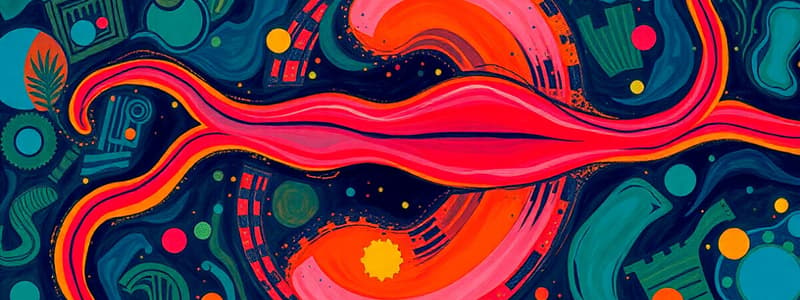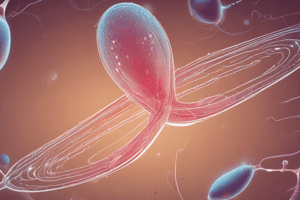Podcast
Questions and Answers
What is the primary function of Sertoli cells in spermatogenesis?
What is the primary function of Sertoli cells in spermatogenesis?
- To initiate meiosis in spermatogonia
- To produce testosterone
- To store mature sperm cells
- To support and nourish developing sperm cells (correct)
During spermatogenesis, what is produced after meiosis II?
During spermatogenesis, what is produced after meiosis II?
- Mature sperm cells
- Secondary spermatocytes
- Four spermatids (correct)
- Primary spermatocytes
Which hormone is primarily responsible for stimulating testosterone production in males?
Which hormone is primarily responsible for stimulating testosterone production in males?
- Gonadotropin-releasing hormone (GnRH)
- Luteinizing hormone (LH) (correct)
- Follicle-stimulating hormone (FSH)
- Prolactin
Which structure develops from secondary spermatocytes?
Which structure develops from secondary spermatocytes?
What are the components of the head of a sperm cell primarily responsible for?
What are the components of the head of a sperm cell primarily responsible for?
What hormone is primarily responsible for the development and functioning of male sex organs?
What hormone is primarily responsible for the development and functioning of male sex organs?
Which of the following best describes the process of spermatogenesis?
Which of the following best describes the process of spermatogenesis?
What role does the epididymis play in male reproductive health?
What role does the epididymis play in male reproductive health?
Which component is a primary part of seminal fluid?
Which component is a primary part of seminal fluid?
What is one of the main functions of the prostate gland?
What is one of the main functions of the prostate gland?
What is the primary function of skeletal muscles in relation to internal organs?
What is the primary function of skeletal muscles in relation to internal organs?
What do we call a bundle of skeletal muscle fibers?
What do we call a bundle of skeletal muscle fibers?
How does muscle contraction contribute to body temperature regulation?
How does muscle contraction contribute to body temperature regulation?
What distinguishes an agonist muscle from its antagonist during movement?
What distinguishes an agonist muscle from its antagonist during movement?
Which of the following statements about bursae is true?
Which of the following statements about bursae is true?
Flashcards are hidden until you start studying
Study Notes
Spermatogenesis: The Process of Sperm Production
- Spermatogonia, the germ cells in the testes, divide to produce primary spermatocytes.
- These primary spermatocytes undergo meiosis I, a type of cell division that reduces the chromosome number, resulting in secondary spermatocytes.
- Secondary spermatocytes then undergo meiosis II, resulting in the formation of four spermatids.
- Each spermatid has a haploid number of chromosomes (23).
- Spermatids develop into sperm cells, undergoing a process called spermiogenesis.
The Structure of Sperm
- Sperm cells consist of three parts: the head, middle piece, and tail.
- The head contains the nucleus, which carries genetic information, and the acrosome, a cap-like structure containing enzymes needed to penetrate the egg.
- The middle piece contains mitochondria that provide energy for the movement of the tail, which is a flagellum.
Supporting Cells in the Testes
- Sertoli cells are found in the seminiferous tubules and play a critical role in spermatogenesis by providing support, nourishment, and regulating the process.
- The entire process of spermatogenesis from spermatogonia to mature sperm takes approximately 74 days.
Interstitial Cells
- Interstitial cells are located between the seminiferous tubules and are responsible for producing male sex hormones, collectively known as androgens.
- Testosterone is the primary androgen and is essential for normal development and functioning of male sex organs.
Hormonal Regulation of Spermatogenesis
- The hypothalamus secretes gonadotropin-releasing hormone (GnRH), which stimulates the anterior pituitary gland to release follicle-stimulating hormone (FSH) and luteinizing hormone (LH).
- FSH promotes the production of sperm, while LH stimulates the production of testosterone.
- Testosterone plays a crucial role in maintaining the male secondary sex characteristics.
Testosterone's Roles in Male Secondary Sex Characteristics
- Testosterone is responsible for the development and maintenance of male secondary sex characteristics, including:
- Increased height compared to females.
- Broader shoulders and longer legs relative to trunk length.
- Deeper voice due to a larger larynx with longer vocal cords.
- Hair growth on the face, chest, and other regions.
- Greater muscular development.
Semen: The Fluid that Contains Sperm
- Semen, or seminal fluid, is a slightly basic fluid (pH of 7.5), containing:
- Fructose, a sugar that serves as an energy source for sperm.
- Prostaglandins, which cause the uterus to contract and propel the sperm towards the egg.
Muscle Contraction & Heat Production
- Muscle contraction causes ATP breakdown.
- This breakdown releases heat, which is distributed throughout the body.
Muscle Protection of Organs
- Muscles act as padding for bones.
- The abdominal muscular wall protects internal organs.
Skeletal Muscle Structure
- Fascicles: Bundles of skeletal muscle fibers.
- Connective Tissue: Surrounds individual muscle fibers and fascicles.
- Tendon: Dense connective tissue that connects muscle to bone.
Fascia and Bursae
- Fascia: Connective tissue covering muscles, extending to form tendons.
- Bursae: Fluid-filled sacs between tendons and bones, acting as cushions and providing lubrication.
Skeletal Muscle Functioning
- Muscles work in pairs for movement.
- Origin: Attachment point to the stationary bone.
- Insertion: Attachment point to the bone that moves.
- Muscle contraction pulls on the insertion tendon, causing bone movement.
Agonist and Antagonist Muscle Pairs
- Agonist (prime mover): Muscle performing the primary action.
- Antagonist: Muscle acting opposite to the agonist.
- Example: Biceps (agonist) flexes the forearm, while the triceps (antagonist) extends it
Overview of the Muscular System
- Functions:
- Movement of the whole organism.
- Movement of substances within the body (e.g., blood, food).
Muscle Tissue Types
- Smooth muscle:
- Cylindrical fibers with pointed ends.
- Uninucleated.
- Arranged in parallel lines, forming sheets.
- Not striated (lacks striped appearance).
- Found in hollow internal organs and blood vessels.
- Involuntary contraction.
- Cardiac muscle:
- Makes up the heart wall.
- Uninucleated, striated, tubular fibers.
- Branched fibers interlock at intercalated disks.
- Complete relaxation between contractions prevents fatigue.
- Rhythmic, involuntary contraction.
- Skeletal muscle:
- Tubular, multinucleated, striated fibers.
- Forms skeletal muscles attached to the skeleton.
- Long fibers running the length of the muscle.
- Voluntary control.
Functions of Skeletal Muscles
- Support: Muscle contraction opposes gravity, maintaining posture.
- Movement: Movement of bones and other body structures (e.g., arms, legs, eyes, facial expressions, breathing).
- Temperature regulation: Muscle contraction generates heat, contributing to body temperature maintenance.
Muscle Fiber Structure and Components
- Sarcolemma: Plasma membrane of a muscle fiber.
- Sarcoplasm: Cytoplasm of a muscle fiber.
- Sarcoplasmic reticulum: Endoplasmic reticulum; calcium storage site.
- T (transverse) tubules: Extensions of the sarcolemma that penetrate the cell and are close to the sarcoplasmic reticulum.
- Myofibrils: Contractile components within the muscle fiber.
- Glycogen: Energy source for muscle contraction stored in the sarcoplasm.
- Myoglobin: Red pigment in the sarcoplasm that binds oxygen.
Myofilaments
- Myofibrils contain two types of myofilaments:
- Thick myofilaments: Composed of myosin.
- Thin myofilaments: Composed of actin.
- Myofilaments run the entire length of the myofibril.
Studying That Suits You
Use AI to generate personalized quizzes and flashcards to suit your learning preferences.




